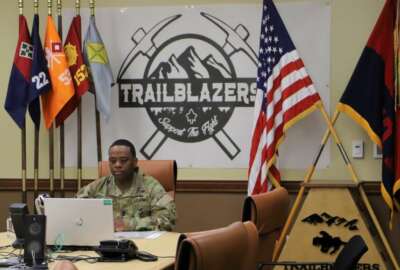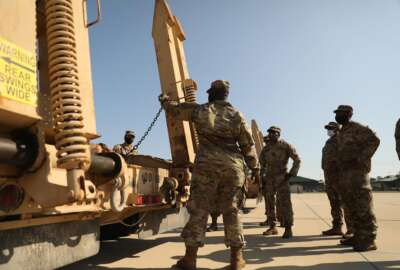
Army cutting costs by sharing services with local communities
The Army is finding new ways to partner with the communities around its bases. Thanks to a 2015 law that lets the military services sign service agreements with...
Five years ago, faced with tightening budgets for the funds needed to operate and support its bases, the Army began a push to save money by sharing services with the communities that lie outside its bases’ fencelines. That effort is beginning to pay off.
Last month, the Army signed the 66th of what are known as Intergovernmental Support Agreements (IGSAs): Public-public partnerships between military installations and adjacent municipal governments. The latest, at Fort Stewart, Georgia, will put local government officials in Long County in charge of animal control services on the garrison.
It’s the fourth IGSA at Fort Stewart alone. Those four agreements have reduced the base’s operating costs by about $2.2 million per year, said Col. Bryan Logan, the garrison commander for both Fort Stewart and the nearby Hunter Army Airfield.
“But there’s also a non-financial piece, and it goes back to relationships and ease of execution,” Logan said in an interview for Federal News Network’s On DoD. “For example, with our grounds maintenance IGSA with the City of Hinesville, I speak to the city manager or the mayor probably once a week. We know the majority of the individuals that are on that grounds maintenance team. So when we see something that might be a little askew, it’s a phone call — it’s not the bureaucracy that we would deal with in a contract. That’s why I’m a huge fan of it.”
Congress helped grease the skids to increase the military services’ uptake of the IGSA concept in the 2015 National Defense Authorization Act, when lawmakers made clear that installations could enter into partnerships with local governments without having to comply with the strictures of the Federal Acquisition Regulation.
Since then, the Army, Navy, Air Force and Marine Corps have all reported reduced administrative time and improved relationships with the communities around their bases, according to the Government Accountability Office.
In the Army’s case, popular uses of IGSAs include many of the things most people associate with municipal government services — things like animal control, police dispatch and jail services, and waste removal.
But Logan said there’s also room for some creativity. At Fort Stewart, officials used an IGSA to sign an agreement with Georgia Southern University to help calculate the base’s overall impact on the local economy.
“We were going to have to have an outside contractor come in, conduct that study over probably a year or two and then give us the results. So we looked and said, ‘Can it meet the standard of an IGSA?’ That way, we avoid the contracting timeline, and we also wanted to see if we could keep it local,” he said. “Can we utilize an organization that truly understands the impact and maybe is a recipient of federal money for the local area?”
The Army’s Installation Management Command (IMCOM) and officials at its Pentagon headquarters offer support services for local commanders who are pursuing IGSAs, and agreements worth $3 million or more require approval from the deputy chief of staff for installations (G-9).
But Army officials have promised to review and approve those agreements expeditiously. In Fort Stewart’s case, base leaders got help from both of the higher-headquarters organizations, said Travis Mobley, the director of Fort Stewart’s plans, analysis, and integration office.
“We had brainstorming sessions internal to the garrison, but then the G-9 and IMCOM would help steer us in the right direction: here’s the regulations, here’s the memorandums that you need to do, the cost-benefit analyses,” he said. “They kind of got us into the crawl and walk, and now we’re basically up and running. But without their support, it would have been very difficult. And I imagine a lot of installations are really challenged to put a foot forward because they don’t know what opportunities are out there. It’s another mechanism to deliver the same service, but at a reduced price, while also keeping things local.”
For installation commanders who might be considering a public-public partnership for the first time, Logan said the first step should be to get a solid understanding of the local government’s capacity and capabilities.
“There’s a lot of people out there that see money. They see opportunity. And sometimes they overplay their hand, so you’ve got to make sure the proof is in the pudding,” he said. “These are no-fail opportunities, so if they don’t have enough lawn mowers or can’t hire enough employees, that’s probably not the right deal. It starts with a handshake and then staff work. Some of these take a year, some of them take three years. But do all of your homework.”
Copyright © 2024 Federal News Network. All rights reserved. This website is not intended for users located within the European Economic Area.
Jared Serbu is deputy editor of Federal News Network and reports on the Defense Department’s contracting, legislative, workforce and IT issues.
Follow @jserbuWFED





